The car
I rented the car from the Porsche Museum in Stuttgart. It turned out to be a brand new Porsche Taycan Cross Turismo 4S. It has a base price of €110,000 in Germany. And it had just about every option ticked, with over €45,000 in extras. So it is the perfect example to test all of the features that Porsche currently offers.

The interior is fitted with a digital instrument cluster, a center screen, a screen for the climate controls, and an optional passenger display. Since I wrote about the interface in detail in my previous post, I'll only briefly cover some new things I noticed.
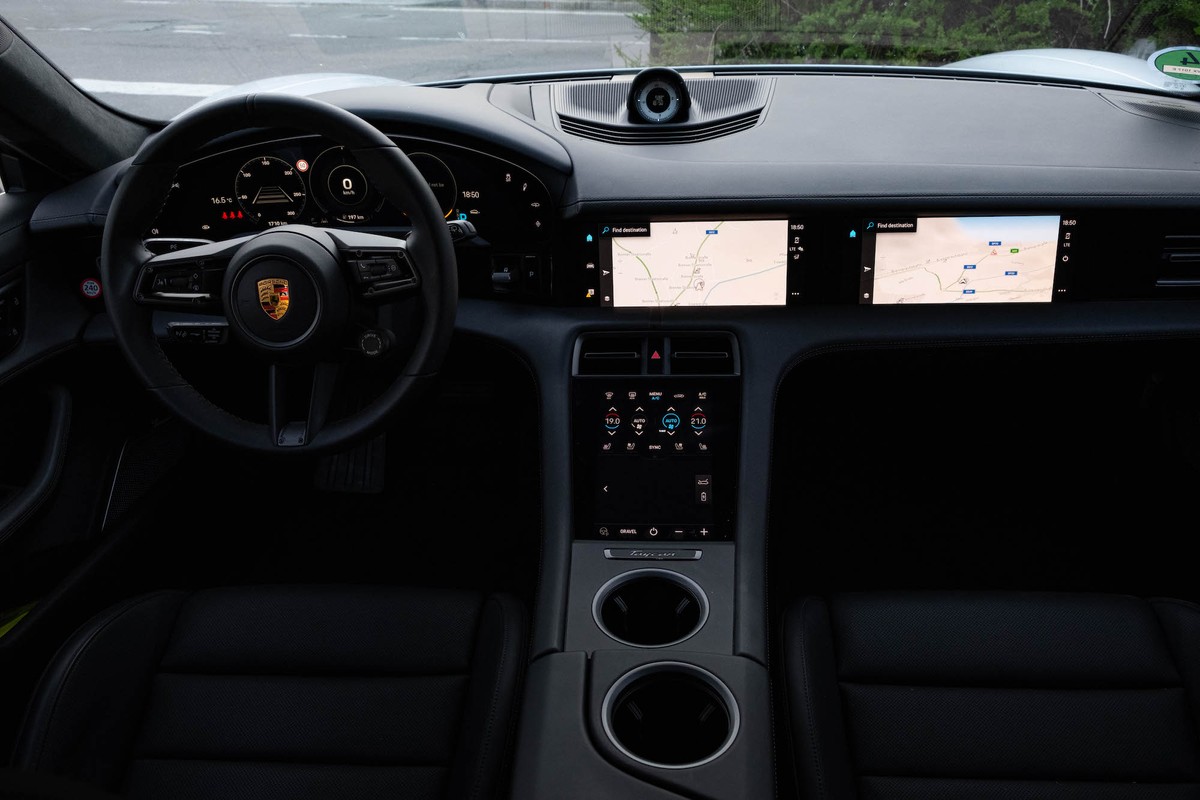
The instrument cluster
The cluster is the showpiece of the interior. It is a fully digital, curved display. As is typical for Porsche, it extends beyond the steering wheel. It is clearly a high-quality screen. There is hardly any sunlight reflection and the blacks are really dark. The UI design, although crowded, is modern and fits the car well.

A clever touch is that the legally required warning icons are in a separate trim piece below the display. This gives the designers and engineers more freedom to design the cluster interface.

On each edge of the display, there are 4 touch buttons for quick interactions, like turning on the headlights. They are close to your natural hand position on the steering wheel and easy to operate.
You can assign one of these touch buttons according to your preferences. I set it to the toggling the electric engine sound. Of course, it is artificial, but I liked it. Similar to the touch button, there is one configurable button on the steering wheel. I found it strange that there is no skip song button on the steering wheel, so I assigned it to the configurable button.
The climate controls
I like that the climate controls are on a separate display. It makes them easy to reach and cleans up the interface of the center display. The interface is clear and intuitive. The touch targets could be bigger, though.

The display is of questionable quality. It only registers hard presses. I suppose it is to prevent accidental touches. But that makes interacting with it much more difficult. There is haptic feedback as a confirmation of a successful button press. But there is also auditory feedback, like in the rest of the system. This makes the haptic feedback unnecessary to me.
Because of the touch input and the hard press, I noticed I had to look down a lot to verify if my finger was in the correct position. It would have been great if the haptic feedback would help guide your finger to the touch area instead of serving as a confirmation.
The bottom half is a permanent touchpad. You can control the center screen with it. But the center screen is designed around direct touch input, not an indirect touchpad. So touching the screen directly is much easier and less distracting than using the touchpad, making it unnecessary.
I have yet to find a system that works well with two different input methods. Typically, it is nearly impossible to optimize the interface for more than one. The car is another example of that. It would have been great if Porsche used the touchpad space to increase the size of the climate controls.
Porsche, like many other carmakers, has placed the airflow direction on the touch interface. In the Taycan, it is in the center display. According to Porsche, the main advantage is that you can save your preferred airflow settings to your Porsche profile, so the airflow will always be like you want, even if someone else drove the car and adjusted it.
I’d much rather just adjust that on the vents directly. However, the A/C in the car is so good that I did not feel the need to adjust it. This makes me wonder if you need it at all. I just set it to ‘diffused’ and left it.
The center screen
Clearly, the instrument cluster and the climate controls are unique to the Taycan (for now). The center screen, though, is fitted to most Porsche models. The UI looks different and outdated. Porsche could have done a better effort to align the design of the different screens. It is also too slow and clunky for a €100,000+ car.

In my previous post, I covered the unusual menu structure. The three tabs in the left menu bar don't make sense as most of the relevant features are under the home tab. I wanted to spend some more time sharing my experience with it, but I noticed that Porsche sent out an update fixing most of the problems.
My car unfortunately had not been updated. I love seeing car companies pushing out these updates and clearly improving the system. Although, I would have expected a much greater improvement in the visual design. Even after the update, it still looks outdated.

The car also had the optional passenger display. It has pretty limited functionality. I can see this becoming more useful in the future if you can stream movies on it or play games, but its purpose today is mainly to drain the battery a bit faster.

The trip
I rented the Taycan for a week and it came with 1700 included kilometers. So obviously I picked a route to get the most out of that range. I drove from Stuttgart via some amazing mountain roads to Bologna and back. During that trip, I used the Porsche infotainment as much as possible. I obviously got a ton of feedback. But three main points stood out to me: connectivity, route planning, and complexity.

Connectivity
As I mentioned above, the Porsche infotainment system looks outdated. Unfortunately, the same can be said about the functionality. It is not designed around apps. You can use Spotify or Apple Music, but those seem to be added as an afterthought. We are used to having access to our favorite apps on all of our devices. I can use Google Maps anywhere I want. I can simply log in to Google Maps on a new device and all my favorite locations and search history is there. Yet, I can't look up a route in Google Maps and send it to the car or use Google Maps as my main navigation system inside the vehicle.
Porsche does offer a companion app that does several things, like planning a route and sending it to the car. Unfortunately, I could not use it because the car was a rental. But like the rest of the system, it forces you to use the Porsche software. You can only plan a route in the Porsche app with the Porsche route planner and send it to the Porsche navigation system.
The choice is then quite simple. I can take my phone and use my favorite apps to look up a route and prepare a playlist, enter the car and have everything instantly there with Apple CarPlay. Or I can download a new app to my phone, use a worse route planner with a pretty useless search algorithm, enter the car, log in to different media apps, and use the unfamiliar Porsche navigation system.
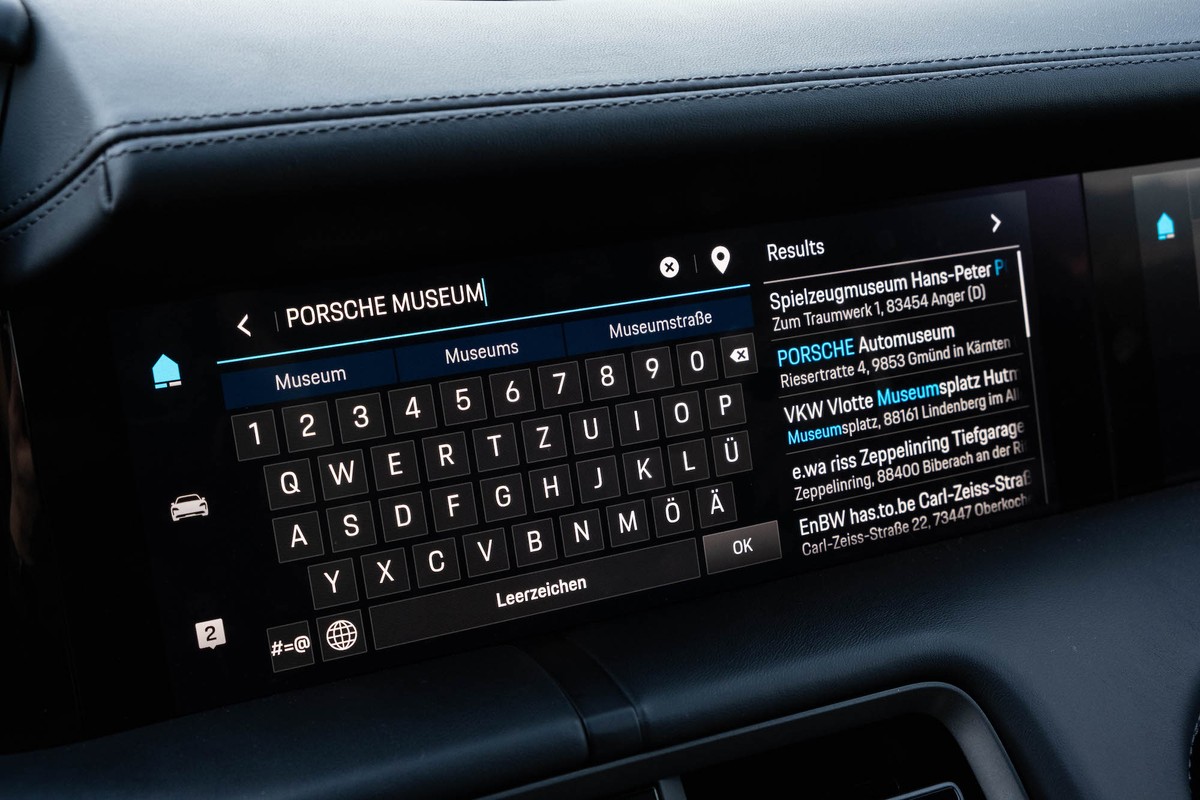
It amazes me that in the 8 years since Apple CarPlay and Android Auto were released, very few carmakers have built systems that can rival those running on our phones. In theory, carmakers can offer something much more valuable because Apple CarPlay and Android Auto hardly exchange any data with the car, making them quite simple. Yet, it is taking embarrassingly long for carmakers to figure it out and Porsche is not even close.
Route planning
The Taycan has a range of around 370 - 400km and especially in Italy, there aren’t plenty of good charging stations around. A great route planner is crucial.
Unlike me, The Porsche Charging Planner takes into account a ton of variables, such as charge level, temperature, traffic, and more. Theoretically, it should be able to come up with a much better route than me, or a navigation app on my phone. And because of that, it gets a little arrogant. It assumes it knows the best route and won't accept any feedback from me. The problem is that in 9 out of 10 cases, it is definitely not the best route.

For example, one day I had to go on a 300km drive with 330km of range. I noticed the route planner selected a charger right before my destination. To me, this was a strange decision to charge so late if there are plenty of chargers on the way. But surely the car knows best. Well... it was not ok at all.
The route planner and the car had different opinions about when it was best to charge. Because with only 60 km of range left, the warnings started to come. With only 40km of range left, I neared the town of my final destination. I noticed that the charger the route planner had selected was 5km uphill at a Volvo dealership.
The car, on the other hand, very concerned with the charge level, suddenly slowed without warning from 130 km/h to 100km/h. The car behind nearly crashed into me. It is definitely not acceptable to slow down suddenly without warning the driver.
I knew there was a good charging station somewhere in the town, so I stopped and tried to get the navigation system to select that charger. I didn’t succeed. I could not figure out how to change the route or find the charger. So I used Apple CarPlay and drove there with Google Maps.

It is a mystery to me why Porsche decided it was better to drive halfway up a mountain to a Volvo dealership if a great charging station is available that is closer.
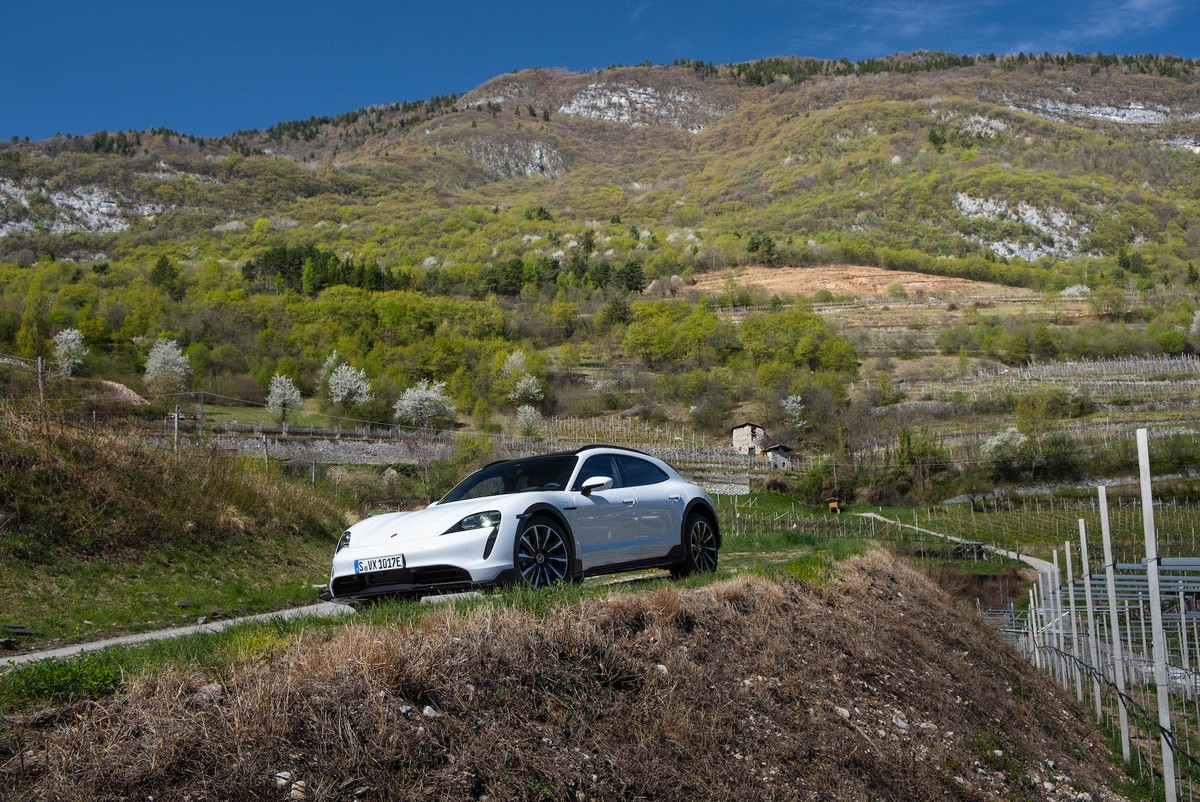
Planning a route does not only depend on technical variables like range and traffic. There are more 'human' aspects to consider that are impossible to get right every time. For example, things like planning a charge around my lunchtime, my favorite roads, or when I want to stop for a toilet break. Therefore, instead of forcing a route, the route planner should facilitate a continuous conversation with the driver. The car should suggest a route but give alternatives, communicate clearly why it chose the route, and make it easy to adapt it to the driver's needs and input. The Porsche, however, does not allow this conversation to happen. It suggests a route, convinced it is perfect, and if you want to change it, you are in bad luck.

Google Maps is only slightly better as it always shows alternative routes and makes it easier to change on the go. But even that is quite basic. Designing a good navigation system is incredibly difficult and I can dedicate an entire post to this topic. But in short, if Porsche forces you to use their own system, I expect it to be a lot better. Porsche is continually updating their software to improve route planning and navigation so I'm curious how it will develop. In any case, I'd rather have the option to use a navigation system I'm familiar with than be forced to use one developed by a carmaker.

Complexity
One reason it is so difficult to do seemingly simple tasks like changing the route is that the infotainment system is incredibly complex. There are 94 different system settings for the infotainment system, 26 different drive/comfort settings, and 25 different cluster display options.
The main reason for this is that Porsche wants to offer personalization to its customers. It thinks that its customers relate a high level of personalization to luxury. I am sure that a group of Porsche customers are eager to explore all the 94 different infotainment settings, but I’ll bet that most of them don’t. And even if that minority is important to Porsche, there is a limit.

Here is an example. I arrived at a hotel one late afternoon and I plugged the car in to charge. The receptionist kindly asked if I could charge the car only at night as it is cheaper for them. No problem, I thought, I just configure the car to charge only at night. It sounds like a simple thing to do but I actually had to watch a 6-minute tutorial video by Porsche to figure this out. Here is how to do it:
- Go to the charge ‘app’ on the home screen
- Go to the ‘Profile’ tab
- Create a new profile
- Set the minimum charge level that it will charge to no matter what
- Choose between optimized charging (only if you have suitable equipment, whatever that means) or a charge time
- Go back to the menu and activate the profile
- Go to the ‘Timer’ tab
- Select add a new timer
- Enter the date and time of departure
- Set target charge level
- Go back to the menu and activate the timer
I actually gave up after step 7 and just plugged the car in before I went to bed.
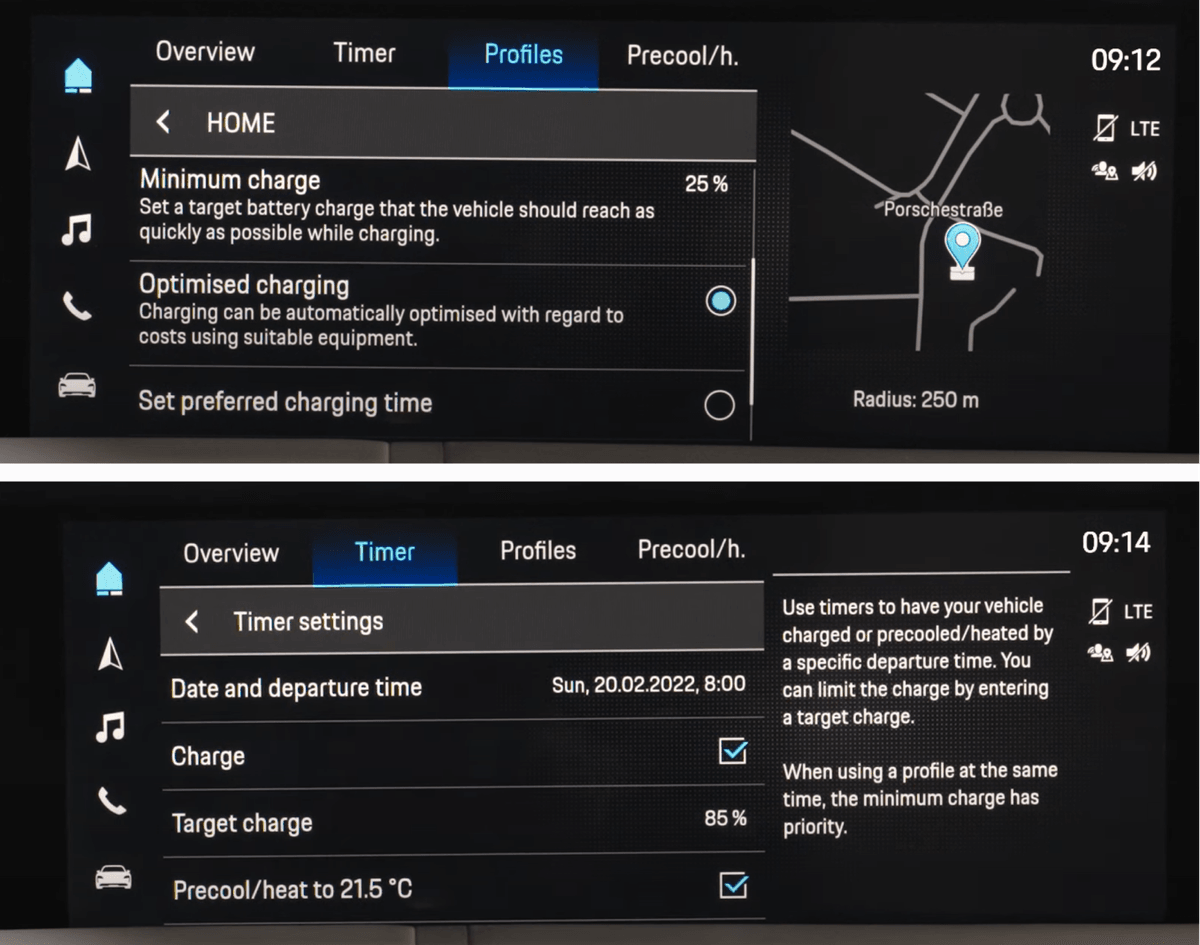
This is a good example of how tailoring to the group of customers that want customization disadvantages the rest. Simple interactions, like setting a charge time, become complicated quickly. Now imagine this for almost every feature in the car.
Which of the 25 different cluster options do you want to see? Do you want to see the date first and then the charge level or the other way around? How bright do you want the ambient light to be? And which color? Do you want the ambient color of the cupholder to be at a different brightness from the other panels? At times, I felt like I was doing the work of the designers.
In every other sector, luxury means taking away as many concerns and decisions as possible. For example, in an expensive hotel, the luxurious experience comes from the staff anticipating your needs. They don’t start asking a bunch of questions to personalize your stay upon arrival. How big do you want your towel to be? How many towels do you want? What color do you want your towel to be? Which soap would you like? How many?
This is what the Porsche feels like to me. I don't know why the car industry thinks differently about luxury compared to every other sector. I don't want to go through endless menus and decisions, I want the smart people of Porsche to make these decisions for me.

Interestingly, there were cases where this happened. And those interactions were delightful!
For example, whenever an object is close to the car, the parking cameras turn on automatically. When going through a toll booth, or when parking, the car helps you out a little by anticipating that you need the cameras. When you accelerate, it disappears again. None of my input is necessary. It is a little sign of the car caring about me. Obviously, it is not perfect. For example, in busy Italian towns, the cameras turn on every time a Vespa races through the traffic jams. But it is better to turn off the cameras at that moment than to turn them on when you need them.
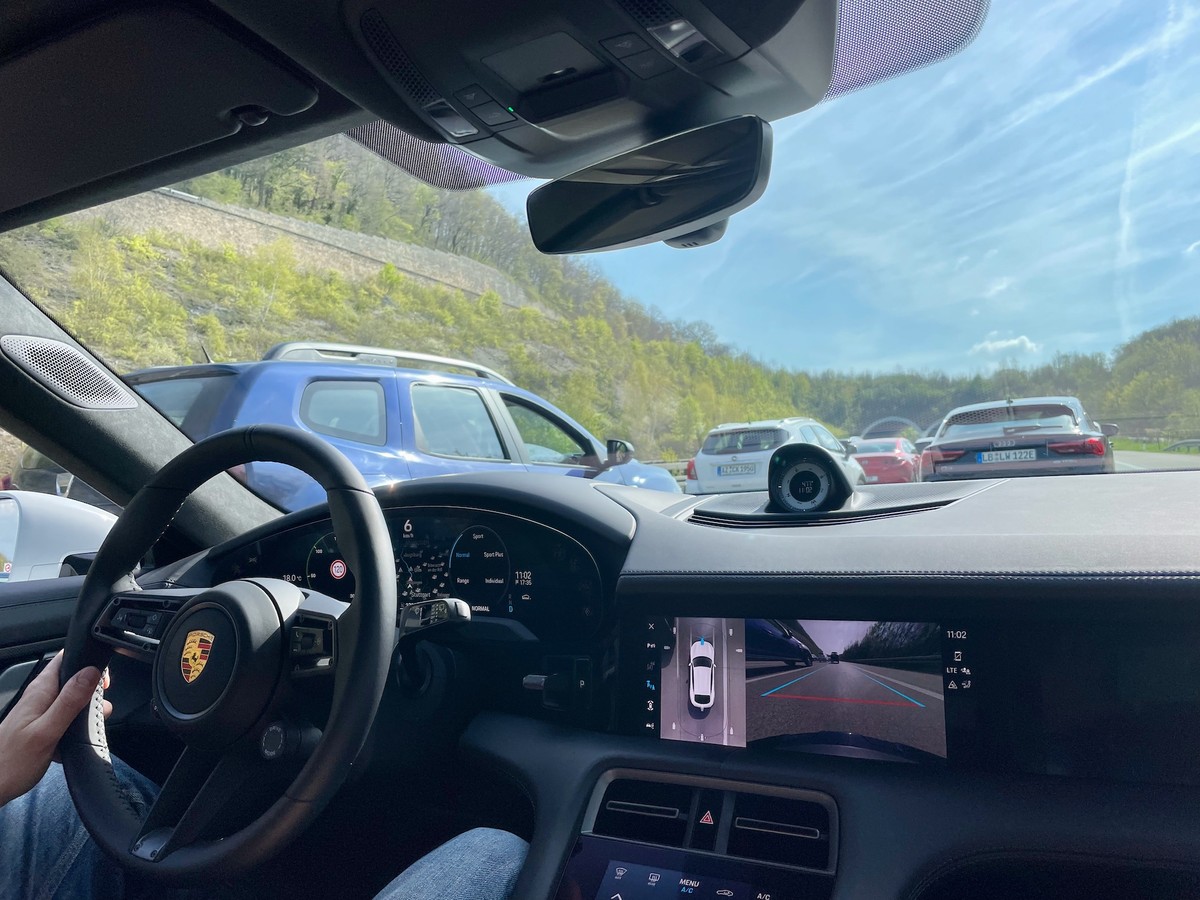
Another example is that whenever you want to raise the ride height of the car, for example, for the dirt road that led to my hotel, it shows a notification asking if you want to do this every time at this location. You confirm this once, and the car will take care of it every single time in the future. Perfect!

To me, that is what luxury is about. Anticipating what I need and presenting it at the right moment.

Does all of this mean that the Porsche is a bad car? Not at all. I loved every minute of driving it. But in a car where everything feels so well designed and effortless, the infotainment stands out.

The three problems that I described also apply to most carmakers. They have also existed for years now and it is taking embarrassingly long for them to come up with a solution. Even though I tried to use Porsche's infotainment as much as possible, I even couldn't help but use Apple CarPlay sometimes. In theory, carmakers can offer a system that is a lot better than something projected from your phone. But if they can't figure out how soon, they risk losing control over that essential part of the driving experience with themselves to blame for it.

Get notified of new posts
Don't worry, I won't spam you with anything else

